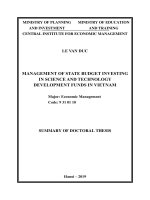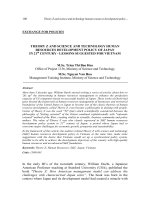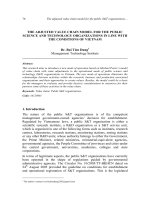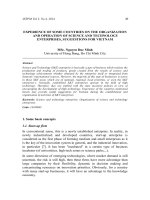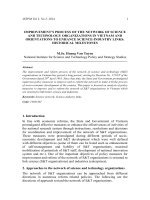Experiences of priorities of investmentfor science and technology development at local level by advancing countries in the region
Bạn đang xem bản rút gọn của tài liệu. Xem và tải ngay bản đầy đủ của tài liệu tại đây (207.21 KB, 8 trang )
JSTPM Vol 5, No 1, 2016
47
EXPERIENCES OF PRIORITIES OF INVESTMENTFOR SCIENCE
AND TECHNOLOGY DEVELOPMENT AT LOCAL LEVEL
BY ADVANCING COUNTRIES IN THE REGION
M.Sc. Luu Thi Lam Giang
Center for Vietnam Science and Technology Internationalization Promotion
Dr. Bui Tien Dung
Management Training Institute
Abstract:
Priorities of investment for science and technology (S&T) development at local level by
other countries in the region are studied on basis of analysis of some components including
friendly investment environment, policy environment and shifts of local economic structure.
At the same time, the authors conducted studies of lessons by countries in the region to
highlight priority policies for local S&T development in short-term, mid-term and longterm visions.
Keywords: Local; Development investment; S&T.
Code: 15122901
1. Introduction
One of the basic components for analysis of priorities for local S&T
development investment is to compare the model and the road map of
development of Vietnam and the ones of other advancing countries in East
Asia and South-East Asia regions. It would lead to clarify certain main
reasons of successful results and limitations in implementation of
industrialization and modernization programs of the country and to make
recommendations for strategies and policies of socio-economic development
and S&T development at local level to be applied to match with
development laws, actual status and conditions of Vietnam.
The strongest impacts from local S&T level towards the national
development come from aspects of social development and economic
growth. The role of local S&T level is seen through various areas such as
development, mastering and organization for implementation of application
of directly effective and advanced technologies in production-business
practice. The S&T application at local level is the basic pre-condition to
produce valued products on basis of market demands, and, at the same time,
to support the mobilization of comparative advantages at local level (Ho
48
Experiences of priorities of investment for S&T development at local level…
Ngoc Luat, 2013, 2014). A back view to the real status of the world’s S&T
activities since the second half of the XX-th century shows that the
producing capacities always advanced far from market demands, and
investments were made for development of producing technologies and then
these technologies move to those localities, countries and regions which
meet necessary requirements of comparative advantages to secure the
competitiveness of produced goods in domestic and international markets
(Dang Huu, 2001; Vu Trong Lam, 2004). In this paper, the authors
introduce the most basic views in relation to lessons gained from
experiences by the countries in the region to highlight orientations and
organizational modes for implementation of priorities for S&T development
at local level. Then, some connections to actual Vietnam practice will be
proposed for consideration of suitable solutions for actual local S&T
development in Vietnam.
2. Modes and road maps for local S&T development in recent time
It is possible to say, during the recent 30 years of Doi Moi policy
implementation and at local level, we have passed the process of setting-up
and improving a model of priorities for S&T development investment which
integrates, combines and mixes incomplete development models including:
(1) Friendly investment environment;
(2) Selective approaches public policies;
(3) Changes of economic structures.
The implementation of these S&T development models is not decisive
enough and then cannot mobilize maximally advantages of each model. The
reasons here are easily seen: these models have mutually conflicting
components and then it is very difficult to identify the most optimal and
integrated model of development.
The coordination of the above noted models of development with a suitable
strategy for local S&T development would create comparative advantages
for every stage of local socio-economic development. This is found to be the
main responsibilities of policy-making institutions of local Party
organizations and State authorities.
Socio-economic statistic figures of Vietnam as noted in Tables 1-3 show
well the road maps of development during recent years, particularly since
2005 to now, in various aspects including GDP growth rates, shift of sector
structures, development of high and middle level industrial technologies,
productivity enhancement, quality and efficiency improvement which do not
JSTPM Vol 5, No 1, 2016
49
pass faster than and basically remain similarly to the ones of other ASEAN
advancing countries such as Malaysia. Thailand, Indonesia and Philippines
and clearly slower than China in the similar stage of development, despite of
continuous efforts during the last 20 years to keep the public
investment/GDP rate from 30% to 45%, second ranked to China. This fact
shows that the S&T development strategies are not found compatible and
the model of investment priorities for local S&T development does not fit
development conditions in recent stages.
Table 1. Vietnam GDP growth, 2005-2015 periods
2005
2010
2011
2013
2014
2015
estimated
3,584.3
4,000
4,500
2012
Actual GDP values
(VND thousand
billion)
914.1
GDP growth rate
(%)
7.55
6.42
6.24
5.25
5.42
5.98
6.50
GDP/person rate
(USD)
702
1,273
1,517
1,749
1,908
2,053
2,250
Export (USD
million)
2,157.8 2,779.9 3,245.3
32,447.0 72,236.7 96,905.7 114,529.2 132,032.9 150,042.0 165,000.0
Source: Vietnam Economic Time Magazine and Nhan Dan Newspaper, 21st October 2015.
Table 2. Shift of economic sector structures of Vietnam
Unit: %
Sectors
Year
Total
Agriculture,
Forest,
Aquaculture
Industry,
Construction
Services
2005
100
19.3
38.13
42.57
2010
100
18.89
38.23
42.88
2011
100
20.08
37.90
42.02
2012
100
19.67
38.63
41.70
2013
100
18.38
38.31
43.31
2014
100
18.12
38.50
43.38
2015
100
17.50
39.00
43.50
Source: Vietnam Economic Time Magazine and Nhan Dan Newspaper, 21st October 2015.
50
Experiences of priorities of investment for S&T development at local level…
Table 3. Comparison of MVA/GDP rates of Vietnam and other countries in
similar development stages
GDP PPP/person
(USD)
MVA
(USD billion)
MVA/GDP
(%)
Vietnam (2007)
2454
12.6
24.1
China (1998)
2330
320.0
31.8
Indonesia (1999)
2631
43.2
26.0
Philippines (1994)
2358
13.5
23.3
Thailand (1986)
2817
11.1
23.8
Note: MVA =Manufacturing Value Added
Source: Dr. To Trung Thanh, Hanoi National Economy University, World Bank
Development Indicators (WDI) 2008.
3. Experiences of investment priorities for local S&T development by
advancing countries in the region and comparisons to Vietnam
Then, the next question is put down: What are the experiences of success
and failure the advancing countries in the region have in their activities for
establishment of local S&T development model, implementation of S&T
development strategies to accelerate the growth rate, to re-structure the
economic system, to enhance quality, efficiency and competitiveness
indicators of economic activities. These experiences are found particularly
important in context of competition from China economy with larger scale
and stronger development of local S&T level which let them be workshops
of the world with high competitiveness in all the producing technology
levels. The next brief consideration provides a presentation of the context
they - the advancing countries in the region - were in and the policies they
applied according to models of development, and some comparisons to
Vietnam.
3.1. Japan and South Korea
Japan and South Korea conducted their export driven industrialization and
modernization process, in context of not being required yet to open their
economies.
- Model of friendly investment environment: priorities of application for
domestic and local enterprises but not for foreign investments;
- Selective model in public policies: priorities and offers of favorable
conditions for local enterprises to take initiatives to hold public
investment markets;
JSTPM Vol 5, No 1, 2016
51
- Model of change of economic structures: high focus on investments to
develop manufacturing technologies.
3.2. ASEAN-4 countries (Malaysia, Thailand, Indonesia and Philippines)
The ASEAN-4 countries conducted their export driven industrialization and
modernization process, in context of opening gradually their economies.
- Model of friendly investment environment: priorities of application first
for domestic and local enterprises and then for foreign investments;
- Selective model in public policies: priorities but failure of full
establishment of favorable conditions for local enterprises to take
initiatives to hold public investment markets;
- Model of change of economic structures: not high focus on investments
to develop manufacturing technologies.
3.3. China
China conducted its export driven industrialization and modernization
process, in context of opening gradually their economies.
- Model of friendly investment environment: the order of priorities of
application: first for locally based State-owned enterprises, locally based
domestic private enterprises and then foreign investments;
- Selective model in public policies: priorities and offers of favorable
conditions for domestic enterprises to hold public investment markets in
the following order of priority: first for State-owned enterprises and then
for domestic private enterprises;
- Model of change of economic structures: high focus on investment to
develop manufacturing technologies.
3.4. Vietnam
Vietnam conducts its export driven industrialization and modernization
process, in context of being required to open fast its economy and to
conduct the international integration.
- Model of friendly investment environment: priorities of application first
for locally based State-owned enterprises and then for foreign investments
and domestic private enterprises. Soon, the signed FTAs require the
equality between all the types of enterprises;
- Selective model in public policies: incomplete priorities and failure of full
establishment of favorable conditions for locally based domestic
52
Experiences of priorities of investment for S&T development at local level…
enterprises to hold public investment markets. Soon, the signed FTAs
require the equality between all the types of enterprises;
- Model of change of economic structures: high focus on development of
investment infrastructures while there is no priority yet to develop
manufacturing technologies. The next implementation of FTAs will be the
opportunities for strong shift of investments for manufacturing
technologies for production of consuming goods and key commodities.
As results of difference in the above noted contexts and development policies
as well as the disadvantageous positions in market scales against to China,
the industrialization and modernization process of the ASEAN-4 countries
and Vietnam gain the lower level of growth rates, economic re-structuring,
quality and efficiency of growth, and competitiveness than the ones of Japan
and South Korea previously and China presently. The shifting process of
economic structures in Vietnam passes slowly. By 2015, the share of labor
markets in agricultural, forestry and aquacultural sectors makes 45% of the
total labor forces while the productivity of the labors in these sectors is equal
to 24% of the industrial sector and 30% of the service sector (Table 4).
In the period from 2008 to now, the productivity of China labor forces
overpasses the one of Thailand. The Chinese GDP per capita rate by 2014
was USD 8,000 which is 8 times higher than the one by 2000.
Table 4. Comparison of productivity of Vietnam and some countries
Source: Groningen Department of Conferences and Center of Growth and Development
Global Economic Database (January 2010).
JSTPM Vol 5, No 1, 2016
53
The signature by Vietnam of many bilateral and multilateral FTAs of new
generation such as Vietnam - South Korea, Vietnam - EU, Vietnam - Russia
- Belarus - Kazakhstan, and others, and the implementation of cooperative
mechanisms of ASEAN+3 and ASEAN+6 with big partner countries such
as Japan, China, India, New Zealand and Australia and the membership to
TPP Agreement with 12 nations in the Pacific region will first offer
opportunities for growth of export market and development of products of
manufacturing industries. In long-term vision, however, Vietnam will face
difficulties in development of manufacturing industries since it is required to
open domestic markets for products of the same categories from
industrialized nations.
According to regulations by FTAs, the State can offer priorities for local
S&T development investment through mechanisms of supports for
technology import and transfer by enterprises. Therefore, the demands of
local S&T development for the period of time from now to 2030 are huge
which target the shift of sector structures at local level, reduction of rates of
labor forces in agricultural, forestry and aqua-cultural sectors from 45%
actually down to 25% by 2030 and enhancement of average productivity in
the whole economic system. The local government in Vietnam needs to
make efforts to support investment incentives for S&T development so that
enterprises are able to sustain international competition and to use
maximally market opportunities offered by FTAs and TPP Agreement.
As conclusions
In order to enhance effectiveness of local S&T activities the priorities for
S&T development investment need to go in close pace with the Party and
State policies and strategies for industrialization and modernization as well
as real situation in implementation of these policies and strategies. In the
recent stage, the industrialization and modernization process has not been
able to achieve the initially defined objectives, namely by 2020 Vietnam
basically will become an industrially oriented modern country. The main
objective reason comes from unfavorable international contexts and the
main subjective reason comes from over-spread uses of central, local and
social investment sources. They are used largely for numerous objectives
without being well guided and focused on local S&T development,
particularly for the sector of production and business enterprises at local
level. The shift of economic structures in industrializing and modernizing
orientations, and the enhancement of intensive links for higher rate of
localization in the chain of industrial added values, particularly of products
of manufacturing industries, would create competitive advantages and
products to meet demands of public investments and infrastructure
54
Experiences of priorities of investment for S&T development at local level…
construction of the country. Therefore, as results, the road maps of
industrialization and modernization process of Vietnam are not able to meet
the demands to catch-up advancing countries in the region and the gap
existing for the last 5 years has extending trends. Clearly, the priority of
investments for local S&T development would face difficult problems.
The implementation of the both strategies for socio-economic development
and S&T development at local level need to stick closely to large
opportunities and challenges of deep and global international integration of
Vietnam in the immediate future. On this basis, strategies and policies will
be issued to guide and to encourage local economic sectors to be focused
more for access to, application of and investments for local S&T
development which would enhance competitiveness, efficiency, development
and extension of production and business activities. However, the key to
turn investment sources for socio-economic development and local S&T
development in the next stage to reality is itself the enhancement of efficient
investments for S&T development in locally based enterprises and the
useful contribution for industrialization and modernization objectives of the
country, on basis of higher responsibilities of local Party and government
organizations, political systems and local community. And for S&T sector,
it would be the demands to push up strongly the innovation process of S&T
management mechanisms, the shifting process of public S&T institutions to
enterprise mechanisms, the removal of mindset of subsidizing and/or being
subsidized and the shift to self-governance mechanisms. These demands
require huge efforts and strives from all the stakeholders including S&T
institutions and State management agencies at the both central and local
levels./.
REFERENCES
1.
Vietnam Communist Party, documents of the X-th and XI-th National Party
Congresses. National Politic Publishing House, Hanoi, 2006 and 2011.
2.
Dang Huu. (2001) Knowledge based economy development. Hanoi, National Politic
Publishing House.
3.
Vu Trong Lam. (2004) Knowledge based economy in Vietnam: Concepts and
Solutions. Hanoi, Science-Technics Publishing House.
4.
Ho Ngoc Luat. (2013) Immediate adjustment of S&T investment mechanisms at local
level. Tia Sang Online Magazine, MOST, Issue of August 2013.
5.
Ho Ngoc Luat. (2014) Attraction of social investment sources for scientific research
activities at local level. Dat Viet Newspaper, No. 2014.

